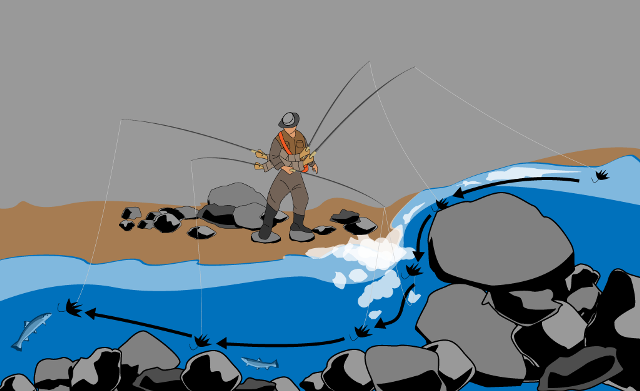Think about the origins of tenkara and western fly-fishing. Tenkara was originated by commercial fishermen, whose livelihoods depended on very efficiently and cheaply catching fish. Instead of spending time tying different flies on to the end of their line, or time and money making different patterns or making sinking devices, they relied on technique, learning how to present and manipulate their one fly. Most tenkara anglers will stick with one pattern only, and make it work with whatever situation they are presented with, even if it means they need to sink a fly without split shot or heavily weighted flies.
Many people believe they need to use a nymph, a heavy hook, or - UGH! - split shot to sink a fly. Casting a line with split shot is one of my worst nightmares, I have done it a few times and hated it. With some technique you can get your fly to sink between 3 and 6 ft, sometimes even more depending on the conditions you're presented. While split-shot, or a heavy Czech nymph will get your fly to sink deeper and faster, I find them awful to cast and one more piece of junk to get lost in the stream or for you to carry, plus, moving one pool upstream will probably produce better results if no fish are taking. One question I get time and time again is how do you sink your fly with no weight?
The first thing you can try doing is casting a bit farther upstream, this will give the fly a chance to soak up more water and sink a bit. Now, here's the cool technique for sinking your fly deeper in a mountain stream. It's really a deadly technique, particularly useful when you find some white water, and you have tried a few techniques but no fish rose. Simply cast the fly upstream from the incoming white water (it doesn't have to be a waterfall looking pool, simply a point with more turbulence). Let the fly drift into the white water, and then lower the rod tip almost all the way down to the water. The intent here is to get as much of your line in the turbulent white water, and get it to be sucked under. As the line gets dragged under your fly goes down with it. After a few seconds you'll feel the line starting to move downstream, as it does you follow it with your rod, slowly and gradually raising the rod tip as the line goes downstream.
TIPS:
- Always strive to keep your line tight. This will allow you to feel anything taking the fly, or for you to see the line stopping/moving in an unusual way, which may mean a fish has taken the fly.
- Variation: As your line starts going downstream, and you start raising the rod tip, try raising the rod tip then dropping it about 10 inches up and down at a time. Every time you lower it you'll need to wait a second for the fly to sink again. This is a great way to entice trout to take, and every small pull up may allow you to hook a fish if one is has your fly and you haven't noticed it.
- Move your rod downstream and slightly forward with it to keep it from swinging.
- The technique works a bit better with level lines, which are denser than the traditional lines.
